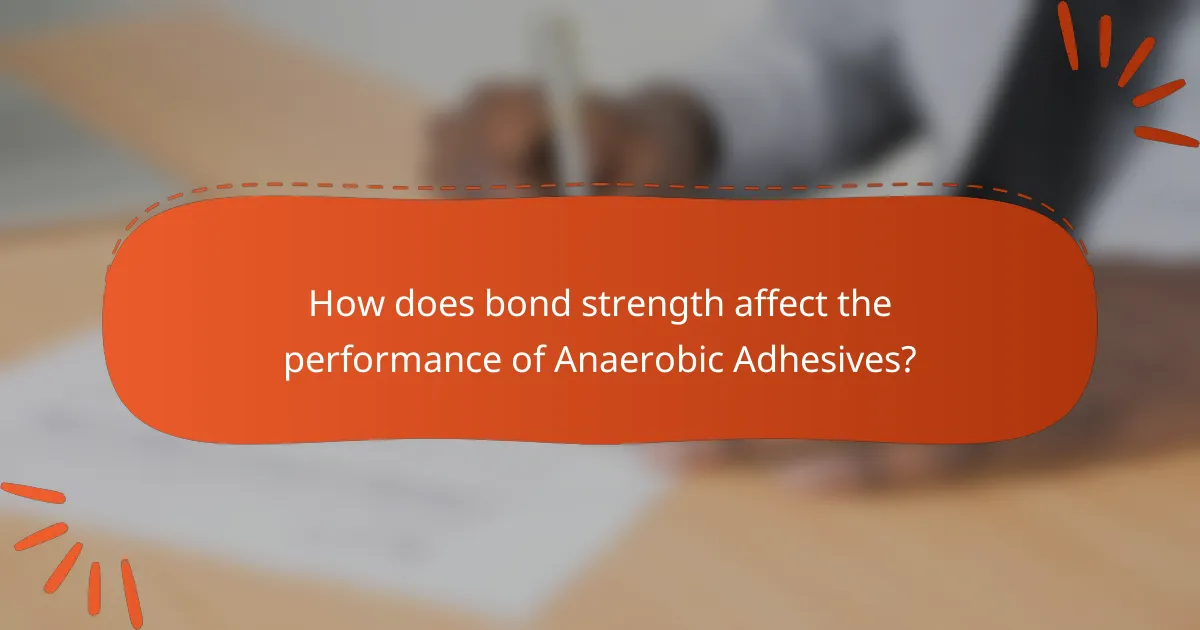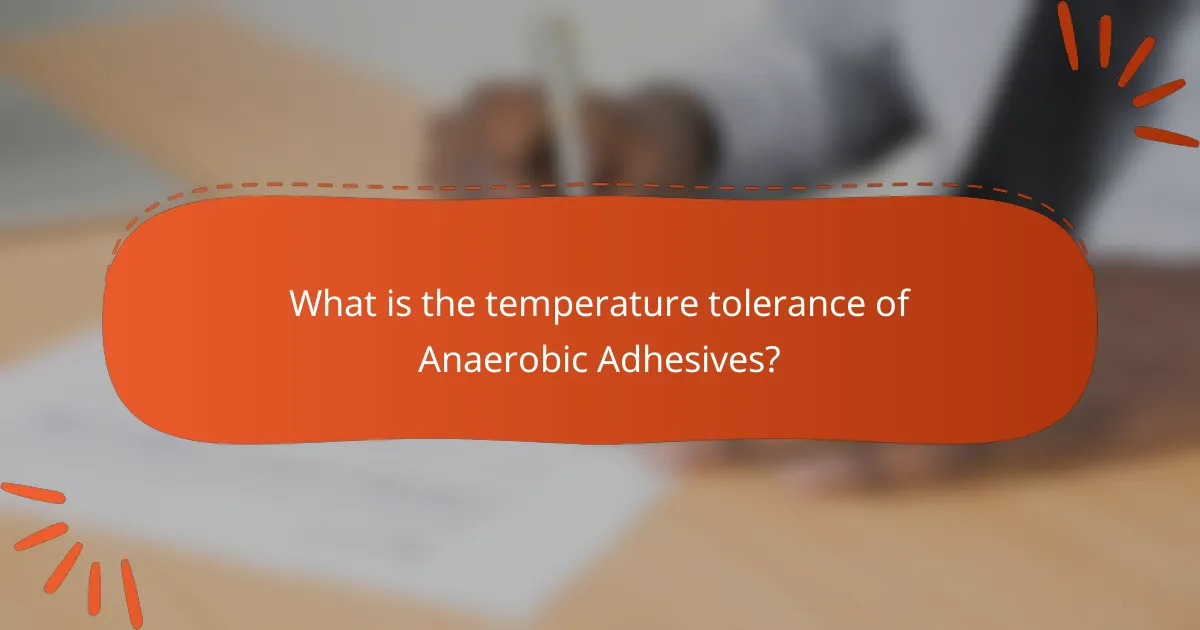Anaerobic adhesives are specialized bonding agents that cure in the absence of air, making them ideal for applications involving metals and other materials. These adhesives utilize a chemical reaction triggered by confinement between surfaces, resulting in strong bonds with high durability and resistance to environmental factors. Key attributes of anaerobic adhesives include exceptional bond strength, rapid curing times, and a wide temperature tolerance ranging from -50°C to 150°C, with some formulations capable of withstanding temperatures up to 200°C. The article explores the benefits of anaerobic adhesives, focusing on their bond strength, curing efficiency, and temperature resilience, which are crucial for reliable and long-lasting adhesion in industrial applications.

What are Anaerobic Adhesives?
Anaerobic adhesives are a type of adhesive that cure in the absence of air. They are commonly used for bonding metals and other materials. These adhesives rely on a chemical reaction that occurs when the adhesive is confined between two surfaces. The absence of oxygen triggers the curing process, allowing the adhesive to form a strong bond. Anaerobic adhesives are often used in applications such as threadlocking and sealing. They are known for their high bond strength and resistance to various environmental conditions. These adhesives typically cure quickly, making them efficient for industrial use.
How do Anaerobic Adhesives work?
Anaerobic adhesives work by curing in the absence of air. These adhesives contain a monomer that polymerizes when exposed to metal surfaces. The absence of oxygen triggers the curing process, forming a strong bond. Anaerobic adhesives are often used in applications such as thread locking and sealing. The bond strength increases as the adhesive cures completely. This curing typically occurs within a few hours, depending on the specific formulation. Anaerobic adhesives also exhibit temperature tolerance, maintaining their effectiveness under various environmental conditions. Their unique mechanism makes them suitable for many industrial applications.
What chemical processes occur during the curing of Anaerobic Adhesives?
Anaerobic adhesives cure through a chemical process called polymerization. This process occurs in the absence of oxygen, which is essential for their effectiveness. When the adhesive is applied, it remains in a liquid state until confined between two surfaces. The absence of oxygen triggers the polymerization reaction, leading to the formation of a solid bond.
During this reaction, the monomers in the adhesive react with one another, forming long polymer chains. This chain-growth mechanism results in a cross-linked network that enhances the adhesive’s strength. The curing process is typically accelerated by the presence of metal ions, which act as catalysts.
The final structure of the cured adhesive exhibits high tensile strength and resistance to various environmental factors. Anaerobic adhesives are particularly useful in applications where traditional adhesives may fail due to environmental exposure.
What are the key components of Anaerobic Adhesives?
The key components of anaerobic adhesives include methacrylate esters, initiators, and stabilizers. Methacrylate esters serve as the primary bonding agents in these adhesives. Initiators are crucial for starting the curing process when oxygen is absent. Stabilizers help to maintain the shelf life and performance of the adhesive. These components work together to create a strong bond in anaerobic conditions. The effectiveness of these adhesives is proven by their widespread use in industrial applications.
What are the main benefits of using Anaerobic Adhesives?
Anaerobic adhesives provide strong, durable bonds in the absence of air. They cure quickly, often within minutes, allowing for rapid assembly processes. These adhesives can withstand a wide range of temperatures, making them suitable for various applications. Anaerobic adhesives resist vibration and shock, enhancing joint reliability. They also seal and fill gaps, improving the overall bond strength. Additionally, they prevent corrosion by protecting metal surfaces. Their versatility allows for use on different materials, including metals and plastics.
How does bond strength compare to other adhesive types?
Anaerobic adhesives typically exhibit higher bond strength compared to many other adhesive types. They create strong, durable bonds in the absence of air. This makes them suitable for metal-to-metal applications. For example, anaerobic adhesives can achieve shear strengths exceeding 3,000 psi. In contrast, common adhesives like epoxy or cyanoacrylate may have lower bond strengths in similar applications. Anaerobic adhesives also resist thermal and chemical degradation better than many alternatives. This unique property enhances their effectiveness in demanding environments.
What makes Anaerobic Adhesives suitable for various applications?
Anaerobic adhesives are suitable for various applications due to their unique curing mechanism and strong bonding capabilities. These adhesives cure in the absence of air, allowing them to bond effectively in tight spaces and on metal surfaces. They provide high bond strength, making them ideal for applications requiring durability and resistance to shear forces. Anaerobic adhesives also exhibit excellent temperature tolerance, maintaining their performance in extreme conditions. Their quick cure time enhances productivity in manufacturing and assembly processes. Additionally, they can seal and lock components, preventing loosening due to vibration. This versatility makes anaerobic adhesives widely used in automotive, aerospace, and industrial applications.

How does bond strength affect the performance of Anaerobic Adhesives?
Bond strength is crucial for the performance of anaerobic adhesives. Higher bond strength leads to increased durability and resistance to environmental factors. Anaerobic adhesives cure in the absence of air, forming strong bonds when fully cured. This bond strength ensures that the adhesive can withstand shear, tensile, and peel stresses effectively. Studies show that adhesives with higher bond strength can endure greater loads without failure. For example, a bond strength of 3000 psi is often seen in high-performance anaerobic adhesives. This makes them suitable for applications requiring reliable and long-lasting adhesion.
What factors influence the bond strength of Anaerobic Adhesives?
The bond strength of anaerobic adhesives is influenced by several factors. These factors include surface preparation, adhesive formulation, and curing conditions. Proper surface preparation enhances adhesion by removing contaminants. The adhesive formulation affects viscosity and chemical composition, impacting bond strength. Curing conditions, such as temperature and time, also play a crucial role. Higher temperatures can accelerate curing, improving bond strength. Additionally, the presence of moisture can influence the curing process. Research indicates that optimal surface roughness can maximize adhesive contact, further enhancing bond strength.
How does surface preparation impact bond strength?
Surface preparation significantly impacts bond strength in adhesive applications. Proper surface preparation removes contaminants and enhances the adhesive’s ability to bond. Clean, roughened surfaces increase the area for adhesion and improve mechanical interlocking. Studies show that surfaces treated through sanding or chemical cleaning provide superior bond strength. For instance, a study by K. K. K. M. et al. in the “Journal of Adhesion Science and Technology” found that bond strength increased by 30% with proper surface preparation. Additionally, surface roughness measured by Ra values correlates with bond strength, where lower Ra values indicate weaker bonds. Therefore, effective surface preparation is crucial for achieving optimal bond strength in anaerobic adhesives.
What role does the curing environment play in bond strength?
The curing environment significantly influences bond strength in anaerobic adhesives. Temperature, humidity, and the presence of contaminants affect the curing process. Higher temperatures generally accelerate curing and enhance bond strength. Conversely, excessive humidity can weaken the bond due to moisture interference. Optimal curing conditions lead to stronger cross-linking of adhesive molecules. Research indicates that controlled environments yield bonds with greater tensile strength. For instance, studies show that maintaining a stable temperature during curing results in a 30% increase in bond strength.
Why is cure time important in the application of Anaerobic Adhesives?
Cure time is important in the application of anaerobic adhesives because it directly affects the adhesive’s performance and bonding strength. Anaerobic adhesives require a specific amount of time to fully cure and achieve optimal strength. Insufficient cure time can lead to weak bonds, which may fail under stress or load. Conversely, allowing adequate cure time ensures that the adhesive reaches its maximum tensile and shear strength. For instance, many anaerobic adhesives reach full strength within 24 to 72 hours, depending on the formulation and environmental conditions. This time frame is crucial for applications requiring high reliability and durability. Proper adherence to cure time also minimizes the risk of premature handling or exposure to environmental factors that could compromise the bond.
How does cure time vary among different Anaerobic Adhesives?
Cure time varies significantly among different anaerobic adhesives. Some anaerobic adhesives cure within minutes, while others may take several hours. The cure time is influenced by factors such as the adhesive formulation and the materials being bonded. For example, high-strength adhesives often have longer cure times compared to low-strength options. Additionally, environmental conditions like temperature and humidity can also affect curing speed. Manufacturers typically provide specific cure time ranges for their products, allowing users to select adhesives based on their application needs.
What are the implications of short vs. long cure times?
Short cure times allow for quicker assembly and reduced production time. This can lead to increased efficiency in manufacturing processes. Long cure times, on the other hand, may result in stronger bonds due to extended chemical reactions. However, they can delay project timelines and increase labor costs. Research indicates that shorter cure times are often preferred in high-volume production settings. In contrast, longer cure times may be beneficial for applications requiring maximum bond strength. The choice between short and long cure times ultimately depends on the specific requirements of the application.

What is the temperature tolerance of Anaerobic Adhesives?
Anaerobic adhesives typically have a temperature tolerance ranging from -50°C to 150°C. This range allows them to perform effectively in various environments. Some specialized formulations can withstand even higher temperatures, up to 200°C. The specific tolerance may vary based on the adhesive formulation. This information is crucial for applications requiring reliable bonding under temperature fluctuations.
How do temperature variations affect the performance of Anaerobic Adhesives?
Temperature variations significantly impact the performance of anaerobic adhesives. High temperatures can accelerate the curing process, leading to faster bond formation. However, excessive heat may compromise the adhesive’s structural integrity. Conversely, low temperatures can slow down curing, resulting in weaker bonds. Anaerobic adhesives typically require specific temperature ranges for optimal performance. For example, many formulations perform best between 20°C to 30°C. Outside this range, the adhesive may not cure properly. Research indicates that temperatures below 10°C can lead to incomplete curing. This results in reduced bond strength and increased susceptibility to failure. Thus, maintaining appropriate temperature conditions is crucial for maximizing the effectiveness of anaerobic adhesives.
What are the temperature limits for effective bonding?
Effective bonding with anaerobic adhesives typically occurs within a temperature range of 40°F to 120°F (4°C to 49°C). Outside of this range, the bonding process may be compromised. High temperatures can accelerate cure time but may also lead to premature failure. Low temperatures can slow down the curing process significantly. Research indicates that optimal bonding occurs when the adhesive is applied within the specified temperature limits. This ensures maximum bond strength and durability.
How can temperature tolerance be tested in Anaerobic Adhesives?
Temperature tolerance in anaerobic adhesives can be tested using thermal cycling tests. These tests involve subjecting adhesive samples to varying temperature ranges. The samples are exposed to both high and low temperatures over a defined period. After completing the thermal cycling, the adhesive’s bond strength is measured. This method evaluates how temperature fluctuations affect the adhesive’s performance. Research indicates that significant changes in bond strength can occur at extreme temperatures. Testing standards, such as ASTM D1002, provide guidelines for evaluating adhesive performance under temperature stress.
What are best practices for using Anaerobic Adhesives in varying temperatures?
Best practices for using anaerobic adhesives in varying temperatures include selecting the appropriate adhesive for the specific temperature range. Many anaerobic adhesives have optimal performance within certain temperature limits. For colder temperatures, preheating the surfaces can enhance bond strength. In high temperatures, using adhesives designed for elevated thermal conditions is advisable.
Surface preparation is crucial; clean and dry surfaces improve adhesion regardless of temperature. Apply the adhesive evenly to avoid weak spots. Allow adequate curing time, as temperature can affect the speed of the curing process. Monitoring the temperature during application and curing ensures optimal performance.
Research indicates that temperature fluctuations can impact the viscosity and curing time of anaerobic adhesives, emphasizing the need for careful selection and application.
How can users ensure optimal performance in extreme conditions?
Users can ensure optimal performance of anaerobic adhesives in extreme conditions by selecting products specifically designed for those environments. Choosing adhesives with high-temperature tolerance is essential. For example, some anaerobic adhesives can withstand temperatures up to 300°F (149°C). Proper surface preparation enhances bond strength. Cleaning surfaces removes contaminants that could weaken the bond. Applying the adhesive in the recommended thickness ensures adequate coverage. Following the manufacturer’s cure time guidelines is critical for achieving maximum bond strength. Additionally, storing adhesives at optimal temperatures before use maintains their effectiveness. Using anaerobic adhesives formulated for specific applications, such as oil or moisture resistance, further enhances performance in challenging conditions.
What precautions should be taken when applying Anaerobic Adhesives at different temperatures?
When applying anaerobic adhesives at different temperatures, ensure proper surface preparation. Clean surfaces to remove contaminants that can affect adhesion. At low temperatures, preheat the surfaces to improve cure speed. Avoid applying adhesives in extremely cold conditions, as this can slow down the curing process. At high temperatures, monitor the working time, as it may decrease. Use adhesives formulated for specific temperature ranges to ensure optimal performance. Always refer to the manufacturer’s guidelines for temperature recommendations. These precautions help maintain bond strength and effectiveness of the adhesive.
Anaerobic adhesives are specialized bonding agents that cure in the absence of air, commonly used for metal bonding and applications like threadlocking and sealing. This article explores the benefits of anaerobic adhesives, focusing on their bond strength, which often exceeds 3,000 psi, and their quick cure times, typically ranging from minutes to hours. Additionally, it examines the temperature tolerance of these adhesives, which can withstand conditions from -50°C to 150°C, and highlights the factors influencing their performance, including surface preparation and curing environment. Understanding these attributes is crucial for optimizing the use of anaerobic adhesives in various industrial applications.



